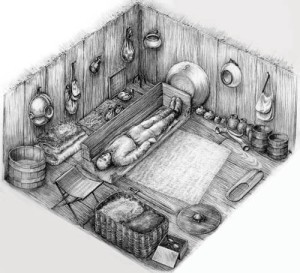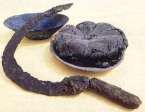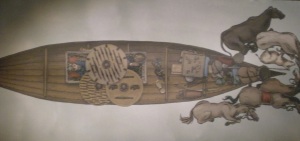
Grave of Saxon man and possessions circa 1000 A.C.E. in England. All images can be clicked on to see up close.
I want to be buried with everything I possess.
Okay, you might think that’s a bit extreme. Did I mean stuff like my car, too? Well, maybe, but it gets way weirder than that. Or does it? It might make perfect sense.
Think about how excited archeologists get when they open a tomb or find a burial spot where lots of the person’s possessions have been placed around them. It offers a unique perspective on life in those long ago times and what was important to people then.
Then there’s the archeological digs that have no funerary goods to give us a window to previous times, so they end up sifting through the garbage heaps instead. Much can be learned from a dump. Even today landfills would give you a similar glimpse into what humans are really up to—what we consume and discard reads like a trend magazine, and a map of our trade connections, not to mention the foods we eat, and the type of health we have.
So what if I was to make my stuff into as perfect a time capsule as I can, and preserve it for some scientists to find a thousand or more years from now? What would I include?
Everything.
I’d start with all the books on my shelves, papers in my files, stories I’ve written, old diaries, photographs and other fragile papery things. I’d include the small folder of ephemera from trips like backpacking around Europe in the mid-1980s that has diaries, bus ticket stubs, currency exchange receipts and info pamphlets from castles and museums.
To round it out, I’d ask my executor to gather an array of the current newspapers and magazines from the day I croak. A big dictionary and a set of encyclopedias would be nice, too. These would all be protected from the ravages of time by being sealed into vacuum-packed bags. (Note to self: get one of those plastic food-sealing machines that let people shrink-wrap food.)
I’d take all the clothes in my closets and drawers, shoes, bags, hats, scarves and gloves, costume jewelry, favorite bed sheets, and a selection of linens. Box up the toys from my childhood, artworks that I’ve made, the knick knacks and souvenirs, award trophies, puzzles, games, clocks, cell phones, and radios.
I realize that all the recording mediums we use except hard copies of written word become quickly obsolete five years after they’re made, let alone a few thousand years from now, but I’d include them as a novelty items. The machines that can play them will be part of this list anyway. Those who rely on the “Cloud” to store information will be disappointed; it will have blown away by then I’m afraid. So throw in computers, music players and music, movies and books on tape and CD collections, and perhaps instruction on how they would need 120-volt electrical power sources to run them!
Would I stop there?
Ha ha, NO!
To give a rounded example of a life circa 20th-21st century, you’d have to include much more, like Pompeii gave us a frozen moment of real life in 79 A.D. I’m talking kitchen wares from shrimp picks to stock pots, glasses, crockery and flatware, napkins, dish soap and all the cleaning and bug killing chemicals found under the sink. To really go the distance, I would even include the (sealed) foods in my cupboards, fridge and freezer, contents of the trash and recycling bins. Hell, I’d even bag the compost separately. With a note saying what it was.
Contents of the bathroom? Of course. Gardening supplies? Yep. Furniture? Uh-huh. Tools and garaged items? Check. Which brings me to the car. I kinda think one of my younger family members might need a car, so I’d not deprive them, but if not, toss it in! The only other things that I wouldn’t include are my beloved art collection so others could enjoy the works of these artists, monies in the bank, (even though I’d probably include examples of coin and currency, in mint condition), and heirloom jewelry that goes to family, although a purist might, and previous human definitely did. Times have changed to include a sense of not wasting precious objects so photos and documentation will have to do in their stead. Once I read about a gutsy guy who wanted to be buried in his Corvette car. There was a big stink from his heirs trying to fight his wishes, but I think it got upheld in the end. Good for him.
Crazy enough for some, but I can see the far-thinking, big-picture people out there contemplating my idea as perhaps valid. An archeologist would have a field day finding this “horde”. They’d probably have a wing of some museum named after them.
Talk about a slice of life!
I know that my race, gender, economic strata, politics, country I live in, etc., etc. would heavily influence the nature of the goods and therefore not give an unbiased view of these times, but a lot could be discerned and extrapolated from many of my possessions. I mean, every one has cooking pots and uses soap, right? Well, I hope so, at least. I guess the homeless have a hard time. But as a general example, I think it would suffice. (See footnote)
So, being detail-oriented, I’ve worked out how this could happen.
I buy a cheap, arid lot in some forgotten corner of Arizona or somewhere. A place that mimics the dry, desiccating effects that preserved the Egyptian grave goods for so long. Dig a big pit and drop a cargo container in it, large enough to hold everything.
The container would be an easy way for my executors to pack and transport all my worldly possessions, too, because I do not see living at this site! Oh no. I leave Sonoma County, California ‘feet first’ as they say. However, I would include a photo documentation of my home inside and out so you could see where all these possessions lived. There would also be a formidable inventory, maybe even little tags tied to the bits giving their names and uses. It would all be explained by a statement of purpose and my biographical information so they’d know who I thought I was, and what I thought I was doing.

Ship cargo containers come in 2 to 3 sizes. Some architects are using them to create modular homes. Maybe I’ll live and be buried all in one seamless flow! Heh heh.
While the bulldozer is there to dig the hole, I’d also have them do deep trenches in a pretty pattern around it, filled with some differently colored rocks that were not native to the area. Something that can be seen from the air or still detected thousands of years from now as not a natural occurrence. Think Nasca Lines. Then mound up the dirt from the hole over the container, level the top and pour concrete on top with designs made out of lava rock embedded in it. I’m still working out what it would be. You can suggest one if you’d like in the comments section.
Final thoughts: I’d will the property to a land trust in perpetuity. As long as it’s far enough from water and people, no one is going to want to live there anyway I hope, and want to grab my site. Remoteness might work in my disfavor if grave robbers get busy, but who’d want vacuum-packed thousand-year-old spaghetti or floor cleaner? However, I am getting an insight into what the Pharaohs must have obsessed about. Perhaps I need to arrange to bring the cargo container in at night and hire the bulldozer from far away so the locals don’t start wild rumors of buried treasure. Or maybe that would lead to wild rumors. Ack!
It would be a shame to have the site vandalized since most of the valuables by modern standards won’t be included. Let them think I’m some nutty new-ager wanting to be buried in the desert with swirly mandalas over my grave site. Maybe it will become a lover’s trysting site complete with my friendly ghost.
 Still think I’m crazy? No? Cool. Yes? Oh well. My ghost will be laughing when my time on Earth is resurrected and people do dissertations on my stuff. I’ll be known as ‘Kim the Forseer’ or something. Maybe ‘Kim the Bizarre’. Ya know, I kinda like either one. Say, has anyone ever looked under the Nasca Lines? I’m just sayin’… 😉
Still think I’m crazy? No? Cool. Yes? Oh well. My ghost will be laughing when my time on Earth is resurrected and people do dissertations on my stuff. I’ll be known as ‘Kim the Forseer’ or something. Maybe ‘Kim the Bizarre’. Ya know, I kinda like either one. Say, has anyone ever looked under the Nasca Lines? I’m just sayin’… 😉








